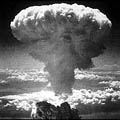Corruptio optimi pessima
(Gregorius Magnus)
・・・そういう意味では 日本の歴史もまた 同じように「巡り巡って」います。
 ただ 日本でのこういった「時代・文化の変化」は 欧米の歴史と比べると とても「急激」で「火」に例える事ができるでしょう。
古くなった建物たちが 突然 破壊されて 変りに新しい建物が どんどん建っていく様子は『燃えて「灰」になり その灰によって栄養が得られ また新しい物が生まれてくる』ようではありませんか?
このように日本は「火」の国です。一時的な破壊は「江戸の華(浮世絵・花火や火事・ケンカ)」でもみられるように 面白がって興味を示す対象になります。
ただ 日本でのこういった「時代・文化の変化」は 欧米の歴史と比べると とても「急激」で「火」に例える事ができるでしょう。
古くなった建物たちが 突然 破壊されて 変りに新しい建物が どんどん建っていく様子は『燃えて「灰」になり その灰によって栄養が得られ また新しい物が生まれてくる』ようではありませんか?
このように日本は「火」の国です。一時的な破壊は「江戸の華(浮世絵・花火や火事・ケンカ)」でもみられるように 面白がって興味を示す対象になります。
そして「平安時代」「江戸時代」のような「広がって発展していく時代」があって、その間に「戦国時代」や「昭和初期」のような「停滞する・とどまる時期」があるのです。
これから話す話は少し単純かもしれませんが 説明のために例として使わせてください。
日本の歴史の面白い特徴の一つは停滞している時期に 欧米と自国の文化を比べ、他国の文化のいい部分を取り入れ見識を広げていきます。
反対に平和な時期は 文化においては閉鎖的になり 海外の情報も「食べ物をゆっくり消化する」ように噛み砕き「日本オリジナル」・「日本的」にアレンジします。
 ただ「巡り巡っている」とはいえ 「第二次世界大戦」による破壊は 以前の歴史とは比べ物にならないくらいそれまでの日本をボロボロにしてしまいました。
ただ「巡り巡っている」とはいえ 「第二次世界大戦」による破壊は 以前の歴史とは比べ物にならないくらいそれまでの日本をボロボロにしてしまいました。
工場や道路、街だけではなく それまでの日本の文化モデルやプライド、 すべてがつぶれてしまいました。 日本人にとってその影響は 思っている以上に大きく、日本人も「それ以降の自国のイメージ」を持つことができずアメリカの文化をそのまま吸収する形となってしまいました。
もちろんアメリカから吸収した文化の中には 沢山の「いいところ」が 日本の文化と混ざっていき日本人の日常の生活にも 様々な可能性や広がりを与えてくれています。
ですが、良い悪いの判断もせずに取り入れた文化の中には 日本にとって良くないこともあります。そしてそれは 時に「癌」のように戦後の日本文化を蝕んでいくこともあったのではないでしょうか?
例えば 日本ではなくアメリカの生活に合わせた 機械化・規格化は 少しずつですが 日本のレヴェルの高い「手作りの文化」「器用さ」「洗練された文化」を衰退させていっています。
また経済面でも 安く買って高く売り、「より高い利益」を求めようとする考え方により 日本は
蟻の巣のようなストレスの渦に はまっていっています。
結果 日本は 消費文化 ストレス 自殺 犯罪 精神的病 などなどの悪循環に飲み込まれて行く原因となっていきます。果たしてこれが日本本来の姿なのでしょうか?
「職業保障」や「機械技術の進歩」など・・・近年において 日本人が日本人的だと思っていた要素は今次第に薄れていっています。
職業の保障も危うくなっているし、機械技術の進歩も いまや他国の進歩に追い越されています。
まるで 日本が蜃気楼を見ていたかのように・・・。
かつて第二次世界大戦の被害をこうむった日本は 根っこまで破壊された状態から立ち上がりました。
そうやって再建していく力は本当に素晴らしい物でした。そして日本は強い国へとなったかのようですがもしかすると まだ「根」の部分が成長しきっていなかったのかもしれません。
今 この状態ではおそらく グローバルな世界で競争していく事は出来ないでしょう。
現在ますます進歩を遂げている 中国やその他のアジアの強い風に対して こんな弱い基盤では太刀打ちできそうにありません。
経済や文化の海外進出、外資金に力を入れすぎている場合ではないのです。
今、この状態で 「発展」をするべきではないような気がするのです・・・。
Real Japan
Also the japanese geopolitical history and culture seems to evolve in a cyclical pattern of expansive and contractive phases.
 The change of ages seems to be more abrupt and dramatic than the patterns we can observe in the European history.In Japan this dynamic resembles very closely that of fire: destruction originates nourishing ashes that can foster new life. Japan, the land of fire, treasures these periodical catastrophes as flowers (Edo-no-hana). Periods of unity and expansion (Heian age, Edo age) alternated with turbulent years of fragmentation and war (Sengoku period or the early Showa period for example).
The change of ages seems to be more abrupt and dramatic than the patterns we can observe in the European history.In Japan this dynamic resembles very closely that of fire: destruction originates nourishing ashes that can foster new life. Japan, the land of fire, treasures these periodical catastrophes as flowers (Edo-no-hana). Periods of unity and expansion (Heian age, Edo age) alternated with turbulent years of fragmentation and war (Sengoku period or the early Showa period for example).
This scheme may be simplicistic but it is functional to the purpose of this analisys. One interesting peculiarity of Japan is that opposite to western models, it is in the contraction periods that Japan opens to other cultures and broadens its view. While in the expansion periods, Japan closes itself and elaborates the knowledge it absorbed from outside into original models that are yet in continuity with the japanese culture.
 This said, the 2WW was destructive like no other event before it. Not only the productive plants, ways of communication, cities were destroyed. The japanese cultural model, the national pride were mortified and raped. The japanese were shocked so deeply that begun to refuse thier own image and absorbed acritically the culture of the invading USA. Some elements were metabolized inside the japanese culture and enriched everyday life with stimulating new possibilities.
This said, the 2WW was destructive like no other event before it. Not only the productive plants, ways of communication, cities were destroyed. The japanese cultural model, the national pride were mortified and raped. The japanese were shocked so deeply that begun to refuse thier own image and absorbed acritically the culture of the invading USA. Some elements were metabolized inside the japanese culture and enriched everyday life with stimulating new possibilities.
Some others developed like a cancer in the vigorous body of postwar japan. Mechanization and standardization (based on standards fit for the USA and not for Japan) slowly eroded the manufacturing culture that used to be one of the richest and most sophisticated of the world. Financial speculation and human exploitation transformed japanese cities into alienating and monotonous ant hills which foster consumis, stress, suicides, criminality. Is this the real Japan?
Some basic concepts providing identity backup to japanese people (job security, technological leadership, subordination to the US) are slowly fading. This may actually be the end of a mirage.
Japan had the courage to grow back even though its roots were eradicated. It is now a strong country but has weak roots. Is it really fit to compete in the globalized world? Japanese economy and culture is too unbalanced towards export and foreign investment. This leaves it vulnerable to the winds of global trends and agressive competition of the emerging countries. There is no point in developing without having roots.
Action: Japan needs to invest in high quality urban environments. Functional, interesting, nurturing cities will promote cultural awareness, peace and economic stability in the medium and long term.
